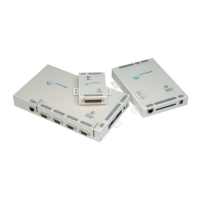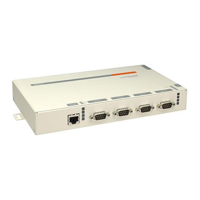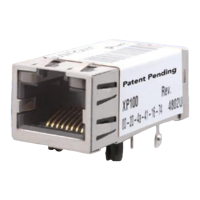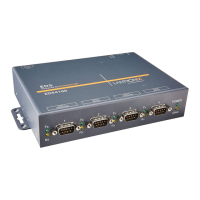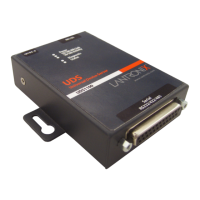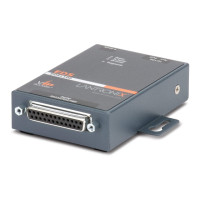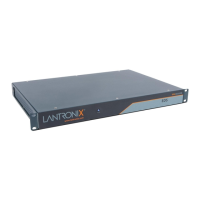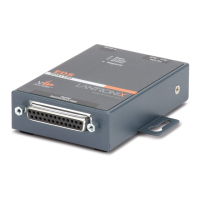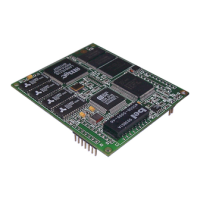8: Device Ports
SLC™ Console Manager User Guide 137
The user will remain connected to the SLC device until they either logout of the CLI session, or
(if Timeout Logins is enabled) the CLI session is terminated if it has been idle.
For PPP connections, the user will be authenticated via PAP or CHAP (determined by the
Authentication setting for the modem). For PAP, the Local/Remote User list will be used to
authenticate the login and password sent by the PPP peer, and the site list will be searched for
a site that (a) the Login/CHAP Host matches the name that was authenticated, (b)
Authentication is set to PAP, and (c) the Port is set to None or matches the port the modem
is on. For CHAP, the site list will be searched for a site that (a) the Login/CHAP Host and
CHAP Secret match the name and secret sent in the CHAP Challenge response by the PPP
peer, (b) Authentication is set to CHAP, and (c) the Port is set to None or matches the port
the modem is on. If the remote peer requests PAP or CHAP authentication from the SLC
console manager, the Remote/Dial-out Login and Remote/Dial-out Password configured
for the modem (not the site) will be provided as authentication tokens.
If a matching site is found, its Dial-back Number, Allow Dial-back, Dial-back Delay, Dial-
out Login, Dial-out Password, Negotiate IP Address, NAT, and Modem Timeout
parameters will be used for the rest of the dial-back connection instead of the parameters
configured for the modem. Once the remote server is authenticated, if Allow Dial-back is
enabled for the site and a Dial-back Number is defined, the SLC unit will will hang up and wait
Dial-back Delay seconds before initiating the dial-back. The SLC device will dial, and if the
remote peer requests PAP or CHAP authentication, provide the Dial-out Login and Dial-out
Password as authentication tokens. Once authenticated, a PPP session will be established
using either negotiated IP addresses or specific IP addresses (determined by the Negotiate
IP Address setting).
Dial-on-demand
The SLC console manager automatically dial outs and establishes a PPP connection when IP
traffic destined for a remote network needs to be sent. It will remain connected until no data
packets have been sent to the peer for a specified amount of time.
When this modem state is initiated, the SLC unit searches the site list for all sites that (a) have a
Dial-out Number defined, (b) have a Static Route IP Address, Static Route Subnet Mask and
Static Route Gateway defined, and (c) the Port matches the port the modem is on. A dial-on-
demand connection will be started for each, waiting for IP traffic destined for a remote network.
When IP traffic needs to be sent, the SLC device dials the appropriate Dial-out Number for the
site, and if the remote peer requests PAP or CHAP authentication, provides the Dial-out Login
and Dial-out Password as authentication tokens. Once authenticated, a PPP session will be
established using either negotiated IP addresses or specific IP addresses (determined by the
Negotiate IP Address setting). The PPP connection will stay active until no IP traffic is sent for
Modem Timeout seconds. Once the timeout has expired, the PPP connection will be terminated
and will not be reestablished for at least Restart Delay seconds.
Dial-in & Dial-on-demand
A modem is configured to be in two modes: answering incoming calls to establish a PPP
connection, and automatically dialing out to establish a PPP connection when IP traffic destined
for a remote network needs to be sent. When either event occurs (an incoming call or IP traffic
destined for the remote network), the other mode will be disabled.
For Dial-in, the user will be authenticated via PAP or CHAP (determined by the
Authentication setting for the modem). For PAP, the Local/Remote User list will be used to
authenticate the login and password sent by the PPP peer, and the site list will be searched for
a site that (a) the Login/CHAP Host matches the name that was authenticated, (b)
Authentication is set to PAP, and (c) the Port is set to None or matches the port the modem
is on. For CHAP, the site list will be searched for a site that (a) the Login/CHAP Host and
